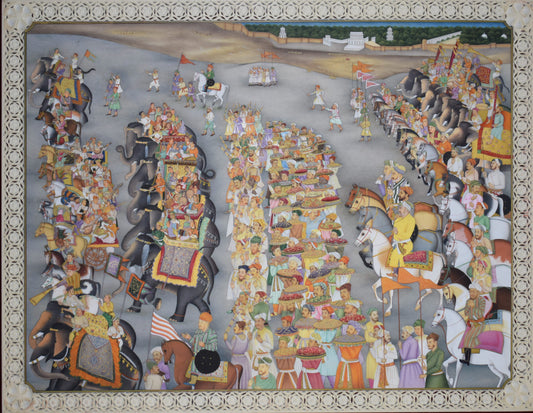Miniature
Filters
Size
Style
Availablity
-
Regular price Rs. 40,000Sale price Rs. 40,000 Regular priceUnit price/
Natural colours on Paper
Sold
-
Regular price Rs. 44,800Sale price Rs. 44,800 Regular priceUnit price/
Natural colours on Paper
Sold
-
Regular price Rs. 44,800Sale price Rs. 44,800 Regular priceUnit price/
Natural colours on Paper
Sold
-
Regular price Rs. 44,800Sale price Rs. 44,800 Regular priceUnit price/
Natural colours on Paper
Sold
-
Regular price Rs. 44,800Sale price Rs. 44,800 Regular priceUnit price/
Natural colours on Paper
Sold
-
Regular price Rs. 560,000Sale price Rs. 560,000 Regular priceUnit price/
Natural colours on Paper
Sold
Miniature paintings, are gorgeous, colourful paintings that are much smaller in size, compared to an average canvas. Most of the contemporary paintings are at least a few feet long and wide, on the contrary, Miniature are only a few centimetres in size. Miniature paintings originated in India during the Pala Empire, spread across eastern parts of India, in around 750 A.D. Originally, Miniature paintings were drawn on palm leaves, and narrated the religious teachings of Buddha. Owing to the limited space on the palm leaf, these paintings were also restricted in size. At about 960 A.D, similar form of painting started taking shape in the western India, under the Chalukya Dynasty. Miniature paintings are created by painting numerous small brush strokes, adding intricate details to the artwork. These paintings are painted using natural colours, i.e. colours made from plant produce such as fruits and vegetables and other natural elements such as minerals, precious metals including silver and gold and precious stones and are usually created on paper or cloth. It often takes weeks to extract and make these colours from the natural sources and their delicacy needs fine brushwork. Thus, even though the paintings are small in size, it takes a very long time to paint them. Religious and mythological stories and Indian classical music, Ragas, musical notes, etc. are the common theme in these paintings. In India, Miniature paintings belong to various schools, including Pala School, Orissa School, Pahadi School, Jain School, Mughal School, Rajasthani School, Deccan School, etc. Though the art form originated during the Pala Dynasty, it reached it’s pinnacle during the Mughal Sultanate and were further promoted by artists from different Rajasthani schools such as Bundi, Jaipur, Kishangarh, Mewar, Marwar, etc. Owing to Akbar’s art appreciation, the artists in his era were encouraged to blend Indian Miniature paintings with Persian style of painting, thus creating a unique style that is now commonly known as Mughal style of painting. This painting style flourished under Akbar’s Rule between 16th and 18th century A.D. As European paintings entered the Mughal Court, these paintings started resonating their effect on the artists and their imagination. During the Mughal Reign, Miniature paintings started leaning towards realism and artists often portrayed scenes from the Royal court, battleground and wildlife expeditions of the king and his army. With the fall of Mughal Empire, Rajput rulers of Rajasthan found interest in Miniature paintings and their artists started painting their unique interpretation of this art form and captured the Royalties and their life in their artwork, along with recreating the mythological stories of Radha and Krishna. The Miniature paintings under the Rajput Rule depicted the brave tales of their valour and portrayed the pictures of their fearless and heroic kings and queens. During this era, Miniature artists were also deeply influenced by the Bhakti Movement of Medieval India and Hinduism, thus, featuring numerous tales from Indian epics such as Ramayana and Mahabharata. These artists used bold and contrasting colours on various material such as paper, silk and ivory. Even today, philosophy, faith and religion play a major role in Indian Miniature paintings.
Sort by
- Featured
- Best selling
- Alphabetically, A-Z
- Alphabetically, Z-A
- Price, low to high
- Price, high to low
- Date, old to new
- Date, new to old












